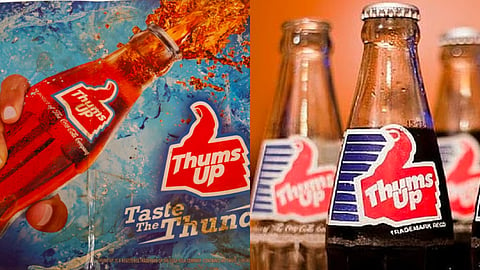
- HOMEGROWN WORLD
- #HGCREATORS
- #HGEXPLORE
- #HGVOICES
- #HGSHOP
- CAREERS
- ABOUT US
- CONTACT US

Once and for all, let's settle the age-old debate on how Thums Up is different from Coca-Cola and Pepsi, and closely follow the journey through which it has established itself as India's favourite cola.
It's known to all how the cola industry has been dominated by two giants, Coca-Cola and Pepsi. Nevertheless, there's one brand that managed to establish itself against the scrutiny and fierce competition posed by these giants- Thums Up. This spicy Indian cola has won many hearts and carved out a niche of its own in the Indian market.
It all began in 1970, when Coca-Cola was reigning over India, and gained a stronghold in the Indian market. However, suddenly in 1977, due to changing regulations and having to reveal its secret formula, Coca-Cola had to stop its distribution in India.
This left a void in the cola market, and the Indian government's attempt to fill it with substitutes like Double Seven didn't quite hit the mark. Campa Cola acted as a substitute that was doing relatively better, however, did not provide the taste which the Indian population desperately craved.
It was during this time that Parle Group saw an opportunity and decided to launch a cola drink made with Indian ingredients. Consequently, Thums Up was born. The original logo featured a bright red thumbs-up gesture with white letters, which was later updated to include blue lines on the left of the thumbs-up image. With this came the slogan, Happy days are back again.
Thums Up's formula was carefully crafted, experimenting with spices like cinnamon, cardamom, and nutmeg. The company aimed to create a fizzy and spicier cola that could be sold by vendors even when not ice-cold. After extensive testing, the Chauhan brothers and their research team succeeded in creating a beverage that stood out as a notable and distinctly Indian alternative to Coca-Cola.
There was also a war for the title of the Better Cola, between Campa Cola and Thums Up, which prompted Thums Up to upgrade the bottle size from the original 200 mL to 250 to 300 mL while retaining the same price. This upgraded bottle, known as Maha Cola, turned out to be an instant hit.
However, apart from Campa Cola, there were other competitors vying for the market share with Thums Up on regional grounds. Some of these brands, such as Bovonto, Dixie Cola, and Sosyo, are still running in India. Moreover, Vijay Mallya also seized the opportunity to enter the cola market by launching his own cola brand called Thril.
Thums up championed in the market due to its marketing strategies. They ran commercials that featured Thums Up alongside typical Indian dishes, such as Samosa, Dosa, and more, reinforcing its Indian identity and distinguishing it from its multinational competitors. The brand also sponsored cricket matches and music events, effectively reaching its target audiences.
Many are not aware of how Thums Up has also found its way into Indian kitchens. The sweet and subtle zesty tint of the cola adds a unique dimension to various recipes, making it a versatile ingredient.
One iconic ad campaign that still rings a bell with people is Taste the Thunder, which further solidified Thums Up's position as a force to be reckoned with in the Indian market. Thums Up continued to reign as the champion, establishing a monopoly over the Indian cola market, or at least until 1987.
Things began to take a turn when, under the government ship of Rajiv Gandhi, with an incentive to increase employment and promote privatisation, Pepsi was allowed to enter the Indian market, bringing significant changes for Thums Up and the cola industry in the country.
Soon, the landscape changed in 1993 during the time of liberalisation in India, the markets were opened further for international brands, swiftly inviting the re-entry of Coca-Cola into the Indian market for the second time. Coca-Cola returned with the slogan Happy to be Here after being absent from India for 16 years.
Coca-Cola, in particular, saw Thums Up as a threat and strategically targeted the weaker aspects of the brand, enticing franchised factories with better incentives. Eventually, Coca-Cola bought Thums Up for $60 million, creating a formidable alliance against Pepsi and acquiring the majority of the market share.
However, even after joining forces, Thums Up retained its individuality and continued to be the leading cola in India. Currently, it commands over 42% of the cola market share and 15% of the market share for all carbonated drinks. So much is its popularity, that even a hill in Maharashtra has been named after the drink.
For many of us, Thums Up has remained a household name, its popularity spanning across generations, with every demography enjoying its spicy fizz. It is the spicy twist, well-executed marketing, and enduring charm of it that has secured Thums Up its place as India's favorite cola.
If you enjoyed reading this, here's more from Homegrown:
Double Seven, The Indian Coca-Cola From The ‘70s
The Longstanding Legacy Of Parsi Raspberry Soda
Blast From The Past: India's Iconic Campa-Cola Is Set To Relaunch This Summer
